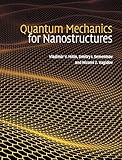Quantum mechanics for nanostructures / Vladimir V. Mitin, Dmitry I. Sementsov, Nizami Z. Vagidov
Publication details: Cambridge : Cambridge University Press, 2010Description: xv, 431 p. : ill. ; 26 cmISBN:- 9780521763660 (hbk.) :
- 0521763665 (hbk.)
| Item type | Current library | Home library | Collection | Call number | Materials specified | Copy number | Status | Date due | Barcode | |
|---|---|---|---|---|---|---|---|---|---|---|
| AM | PERPUSTAKAAN LINGKUNGAN KEDUA | PERPUSTAKAAN LINGKUNGAN KEDUA KOLEKSI AM-P. LINGKUNGAN KEDUA | - | TA357.M584 3 (Browse shelf(Opens below)) | 1 | Available | 00002018865 |
Includes index
'The properties of new nanoscale materials, their fabrication and applications, as well as the operational principles of nanodevices and systems, are solely determined by quantum-mechanical laws and principles.This textbook introduces engineers to quantum mechanics and the world of nanostructures, enabling them to apply the theories to numerous nanostructure problems. The textbook covers the fundamentals of quantum mechanics, including uncertainty relations, the Schrodinger equation, perturbation theory, and tunneling. These are then applied to a quantum dot, the smallest artificial atom, and compared to hydrogen, the smallest atom in nature. Nanoscale objects with higher dimensionality, such as quantum wires and quantum wells, are introduced, as well as nanoscale materials and nanodevices. Numerous examples throughout the text help students to understand the material'--Provided by publisher.
'The properties of new nanoscale materials, their fabrication and applications, as well as the operational principles of nanodevices and systems, are solely determined by quantum-mechanical laws and principles. This textbook introduces engineers to quantum mechanics and the world of nanostructures, enabling them to apply the theories to numerous nanostructure problems. The book covers the fundamentals of quantum mechanics, including uncertainty relations, the Schrodinger equation, perturbation theory, and tunneling. These are then applied to a quantum dot, the smallest artificial atom, and compared with the case of hydrogen, the smallest atom in nature. Nanoscale objects with higher dimensionality, such as quantum wires and quantum wells, are introduced, as well as nanoscale materials and nanodevices. Numerous examples throughout the text help students to understand the material'--Provided by publisher
There are no comments on this title.

